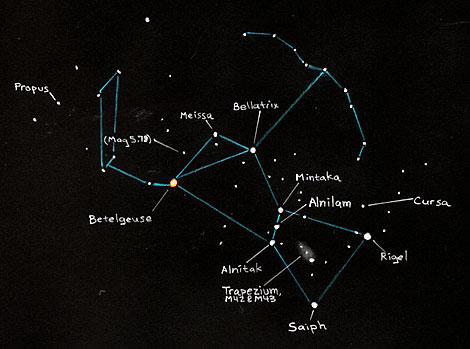 |
Canku Ota
|
 |
|
(Many Paths)
|
||
|
An Online Newsletter
Celebrating Native America
|
||
|
January 2014 - Volume
12 Number 1
|
||
|
|
||
|
Be It Hunter, Canoe,
Chief or Bison, Constellation Orion Is Our Winter Buddy
|
||
|
by Indian Country Today
Media Network staff
|
||
|
Here in the north it is our winter buddy, and it is highest in the sky around now, showcased since the Winter Solstice of December 21. Orion, of course, is from ancient Greek mythology. But the figure factors prominently into many other cultures as well. Orion's stars are features of Lakota astronomy, though as a chief, not as a hunter, and the three stars of the belt are a bison's spine, according to Lakota Ethnoastronomy at Florida International University. The Lakota constellation known as the Hand consists of Orion's belt and sword, the website says. Other indigenous nations don't see a hunter either. To the Chinook Tribe, the stars forming the belt and dagger are two canoes vying to be the first to catch a salmon in the Big River, which is the Milky Way. The little canoe is winning the race and is closing in on the fish, which is Sirius, the bright star in the middle of the river, according to Western Washington State University's planetarium. Besides American Indian cultures, the figure of Orion also features in the lore of Hungarians, Aboriginal Australians, Scandinavian, Babylonian, Egyptian and Chinese, as well as others, according to Wired. The Navajo see Orion as Á tse A ts'oosí (First Slender One), according to the web page So' Naalkaah Navajo Astronomy. Orion is pictured as standing tall, his bow poised to launch an arrow. "This figure is synonymous with the constellation 'Orion' in its location in the sky," says the site, run by a Navajo man. "Á tse A ts'oosí represents protection, as it is depicted in the sky as it moves ahead of the children that make up the constellation Dilyéhé, protecting them." Orion also shows up on the ground in Navajo country, with three sacred mountains corresponding to the same three stars that comprise Orion's belt, according to Navajo ethnobotanist Arnold Clifford. "Once [Orion's belt] comes overhead it lines up with all the three mountains in a row there," Clifford told ICTMN in 2012. "If you draw a line straight and put all those in a line one slightly offset to the south. Same as Orion's belt." In short, the stars tie us all together. Not only are we each and every one of us crafted of stardust, but we also all see pictures in humanity's common-across-the-ages, connect-the-dots game in the sky. |
 |
|
|
||
|
|
||
| Canku Ota is a free Newsletter celebrating Native America, its traditions and accomplishments . We do not provide subscriber or visitor names to anyone. Some articles presented in Canku Ota may contain copyright material. We have received appropriate permissions for republishing any articles. Material appearing here is distributed without profit or monetary gain to those who have expressed an interest. This is in accordance with Title 17 U.S.C. Section 107. | ||
|
Canku Ota is a copyright ©
2000 - 2014 of Vicki Williams Barry and Paul Barry.
|
||
 |
 |
|
|
The "Canku
Ota - A Newsletter Celebrating Native America" web site and
its design is the
|
||
|
Copyright ©
1999 - 2014 of Paul C. Barry.
|
||
|
All Rights Reserved.
|
||
 The
stars in the constellation we know as Orion make such an obvious
figure that just about every civilization, including Indigenous
Peoples, have created mythology about the constellation.
The
stars in the constellation we know as Orion make such an obvious
figure that just about every civilization, including Indigenous
Peoples, have created mythology about the constellation.